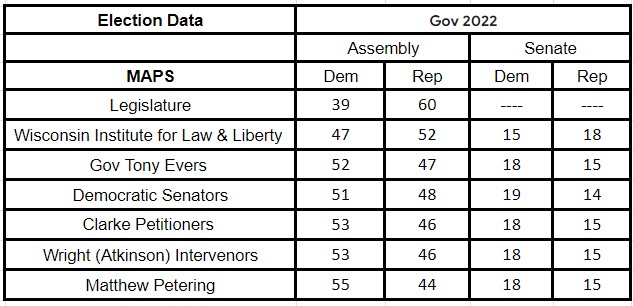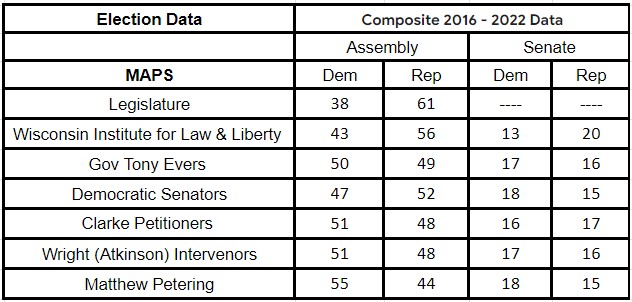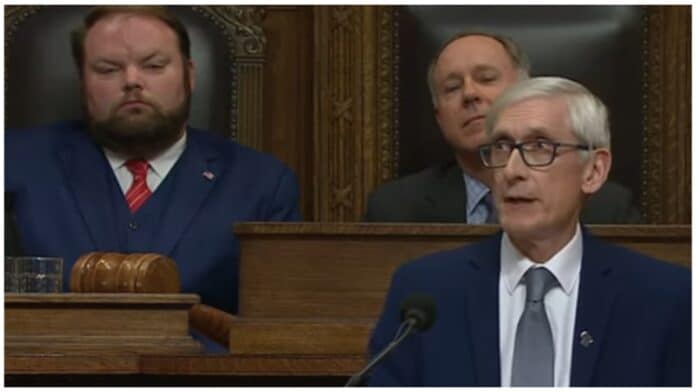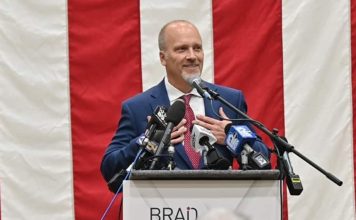Today, the Republican-controlled state Senate approved Democrat Gov. Tony Evers’ redistricting maps which, through many credible scenarios, hand control of the Legislature to Democrats by 2026.
Yes, you read that right. The Republicans in the state Senate voted to approve outrageously gerrymandered maps that most likely give control of the Legislature to Democrats.
All Democrats and all but four Senate Republicans voted for Evers’ maps, with Democrats taking turns shrilly trashing Senate Republicans for… voting for Evers’ maps. Yes, welcome to the theater of the absurd.
Sure, the Republicans made some small tweaks to undo a couple of Evers’ partisan moves. But it’s now being reported that the Assembly might even remove those tweaks. Assembly Speaker Robin Vos even said approving the maps gives “Gov. Evers a huge win,” and he has “no problem with Gov. Evers maps.”
Vos said he has "no problem with Gov. Evers maps."
He added, "If we did that it would save millions of dollars on lawsuits. It would stop a partisan court from gerrymandering the state and we would basically be giving Gov. Evers a huge win." https://t.co/xjMUFgu565 pic.twitter.com/8sNxmomS2f
— Emilee Fannon (@Emilee_Fannon) January 24, 2024
What?
We get that there are no good options here, and good people are trying to make the best they can of it. We think Vos thinks the maps are the least bad option, and that they give Republicans more of a fighting chance than other Democratic maps or something a liberal Janet Protasiewicz court would draw. His comments are likely designed for a single audience: Tony Evers, currently holding a veto pen.
But these are Evers’ maps. It’s just putting lipstick on a pig.
The Evers’ maps are very egregious. For example, according to Republican state Sen. Joan Ballweg, they disenfranchise 671,000 Wisconsin voters by moving them from even-numbered Senate districts (which are up in November) to odd-numbered districts (up in 2026). That means these voters will not get a chance to vote for a state Senator for SIX years. Wisconsinites are supposed to get a chance to vote for state Senators every four years. How is that okay?
It’s not. Yet all Republicans in the Senate – except for Ballweg, Julian Bradley, Chris Kapenga and Eric Wimberger – voted for the slightly tweaked Evers’ maps. “I feel I need to speak up for them (the voters) who are being drastically affected by what the governor’s maps do,” Ballweg said, in casting her “no” vote.
There Was a Better Alternative
This is the same Senate that bottled up the Iowa Maps model in committee last fall even though Vos had the Democratic votes needed to override an Evers’ veto on that one.
That version would have allowed the Legislature to have final say over maps (instead of the liberal court), which would be drawn by the non-partisan Legislative Reference Bureau. On what planet are Evers’ maps better? They are not. Yet this alternative seems dead for inexplicable reasons.
Instead, the Iowa model bill was used as a mechanism to bring EVERS’ partisan maps to the floor of the state Senate and, soon, the Assembly.
We encourage state representatives to vote “no.” And if it comes back to the Senate without tweaks, they should vote no too.
Legislative maps are a hill Republicans should die on. Go down swinging. Go down fighting. Consider impeachment. Take it to SCOTUS (yes, we know that’s a Hail Mary pass.) Passing Evers’ own terrible maps, essentially ceding control of the Legislature to Democrats and throwing away the narrative besides, is surrender.
If you lose in court, take the case to the public. Win it there. We know that’s hard. You still need to try. There’s a new Supreme Court race coming up.
Why Would Republicans Do This?
We spent hours trying to figure out the Republicans’ rationale for doing this. Why would they do this?
We initially heard they were negotiating with Evers to approve the People’s Map Commission maps instead. That would have been arguably borderline palatable. Then, as Tuesday progressed, it became clear that Republicans were starting with Evers’ CURRENT maps, the ones he submitted to the liberal-controlled Supreme Court.
We have heard two main reasons for doing this:
1. There is a belief among some Republicans that the other Democratic maps submitted to the court are worse than Evers’ maps. They all give Democrats control under multiple credible scenarios, but Evers’ maps give them control by a little less.
Judge for yourself in the chart below (which is based on the 2022 governor’s race). The WILL and Legislature’s maps are off the table because those were conservative-drawn, and no one thinks Evers would ever agree to those. Petering’s maps are no longer in play.

Yes, it’s true the other Democratic maps are a bit worse for Republicans. However: This argument strikes us a bit like a person arguing that they will choose to be shot through the heart once, not twice, so it’s a better choice, when the practical matter is you still end up just as dead and with an imploded heart. On top of it, your loved ones can’t really argue anymore than it was horrible you were shot when you asked to be shot.
To choose an analogy less hyperbolic, there’s an old saying that you can’t be a little pregnant. You can be a little less in control of the Legislature, we suppose, but it still allows Democrats to turn us into Minnesota. Or California.
After ticking off a long list of atrocious things in Evers’ very partisan maps, Senate Majority Leader Devin LeMahieu then supported them. “We just wanted to make things somewhat fair,” he said of the tweaks.
2. There is a belief that this might be kabuki theater designed to strengthen a legal argument before SCOTUS. This argument holds that everyone knows Evers will veto the maps. Maybe. But it’s a big risk to take when Evers could… actually sign this! That would eliminate any appeal to SCOTUS.
If #2 was the rationale, then they should have proposed the People’s maps, not Evers’.
What About the Consultants?
Furthermore, it’s possible that the two consultants (hand-picked by the liberal-controlled court) could actually propose maps that are fairer than Evers’ maps. There might be hope for one of them; according to the New York Times, the consultant, a former bartender turned postdoctoral fellow, enraged Democrats in New York with his map-drawing there because he robbed them of House pickups. Their maps are due Feb. 1.
What About SCOTUS?
And there’s always SCOTUS. We understand that conservatives believe the chances of winning before SCOTUS are extremely small. However, the conservative justices kicked Evers’ maps once before… we also understand that the liberal court could choose to draw its own maps. We know that would be awful.
But there’s another arena to play in that isn’t political or legal; the battle for public opinion.
It’s a lot harder to educate the public on how bad Evers’ maps really are when Republicans are voting for them! We get it’s a mitigate-the-harm strategy, but you’re throwing away the narrative – and it’s a narrative that could help former Republican AG/State Supreme Court candidate Brad Schimel or all the vulnerable legislators about to be forced into rushed elections in districts they barely know. Just look at how a Wisconsin State Journal reporter tried to spin it today, making it sound like Evers’ horrid maps are GOP-proposed maps. To be honest, if you vote for it, you have to own it. All of it.
Hey @AlexanderShur – these aren’t GOP maps. They’re Evers’ maps with minor tweaks passed by a state Senate he’s backed against a wall. The Legislature’s maps, submitted to the court, did not disenfranchise anyone. So give us a break. https://t.co/Bo3RUEKJUb
— Wisconsin Right Now (@wisconsin_now) January 24, 2024
The liberal media have tried desperately to confuse the public and legislators into thinking that Evers’ maps (and the other Democratic maps) really aren’t that bad because they actually keep control of the Legislature in the hands of Republicans. This is extremely misleading. It’s based on a single research fellow from Marquette’s theoretical model.
We analyzed the Evers’ maps using Dave’s Redistricting, which is the common software used by experts behind the scenes. The results change depending on which partisan data set you use to determine the partisan slant of a district.
- If you use 2022 governor’s election data, Democrats take control of the Legislature (see above chart).
- If you use 2022 attorney general election data, where the Republican performed somewhat better, Democrats take control of the Legislature.
- If you use election data from a composite of key races from 2016-2022, Democrats take control of the Legislature. Are those odds you want to take?

For example, under the composite data, Republican state Sen. Van Wanggaard’s current district has a 58.2% to 39.7% Republican advantage. Under Evers’ map, it switches to a 50.3&% to 48.37% Democratic advantage AND pits him against another Republican incumbent.
Sure, if you use Ron Johnson’s 2022 race, Republicans end up with a very narrow 17 to 16 advantage in the Senate, and 51 to 48 in the Assembly. However, that race was an anomaly, in which the Republican was extremely well-financed because the election was for control of the U.S. Senate, he was an incumbent, and he faced a historically awful opponent. Not a crapshoot we’d want to bet on when the consequence is a Democratic wish list being rammed through a non-divided government. Furthermore, some of the districts listed as Republican are very tight swing districts. We get that some prefer to use the John Leiber race because it had no incumbent (but did have a third-party candidate) and was an obscure race almost no one paid attention to.
Some people argue that legislators perform better than statewide candidates, giving them a boost. However, Evers’ maps appear to take a number of moves designed to neutralize any such advantage.
They:
- Pit dozens of Republican incumbents against each other and almost no Democrats. The practical effect is that this will force many good Republicans out of public life.
- Force the only black Senate Republican in state history out of the Legislature for two years unless he moved.
- Disenfranchise the 671,000 Wisconsin voters by switching the numbers of districts. According to Ballweg, the small tweaks the Republican Senate made to Evers’ map before approving it Tuesday only slightly reduces this to about 665,000 people.
- Shear conservative areas off of swing districts to make them more liberal.
- Pitted three Republican incumbents against each other in one district.
- Sticks Republican incumbents in new areas where they haven’t built up ties to constituents.
- Targets the state Assembly’s majority leader.
Furthermore, there are other swing districts up for grabs that favor Democrats.
Doesn’t sound very good to us.
Table of Contents











![WATCH: Elon Musk Town Hall Rally in Green Bay [FULL Video]](https://www.wisconsinrightnow.com/wp-content/uploads/2022/04/Elon_Musk_3018710552-356x220.jpg)



![The Wisconsin DOJ’s ‘Unlawful’ Lawman [WRN Voices] josh kaul](https://www.wisconsinrightnow.com/wp-content/uploads/2025/03/MixCollage-29-Mar-2025-08-48-PM-2468-356x220.jpg)







![Phil Gramm’s Letter to Wall Street Journal [Up Against the Wall]](https://www.wisconsinrightnow.com/wp-content/uploads/2025/03/gramm-356x220.png)










